The more time we spend on the water, the more we appreciate the services provided by the U.S. Coast Guard (USCG). Like all prudent mariners, we monitor VHF channel 16 when on the water. Since beginning this sailbatical, we have heard many important announcements from the USCG. Whether alerting boaters to “hazards to navigation,” such as forty overboard containers floating in the Atlantic Ocean near Jacksonville FL, or restricted access to areas supporting navy drills, or marine safety broadcasts, the USCG is a daily presence when we are moving Belle Bateau. Most days, the announcements are mundane, which is a good thing. But each notable warning is a learning opportunity. The USCG will often provide more information or communication on VHF channel 22A, and I usually switch channels and go there to listen in, and learn.
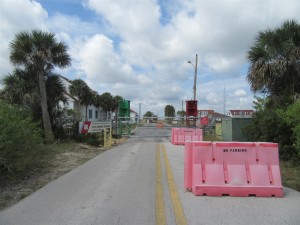
So imagine our delight in meeting someone in New Smyrna Beach (NSB) who works for the U.S. Coast Guard—a female diesel engineer! How impressive is that! We met Lucia through our friend Sarah (see the last blog post: http://sailingbelle.hocomojo.org/2016/03/17/chillin-in-nsb-days-142-153/), and began quizzing her on questions we had been formulating since Day 1 when the Coast Guard radioed us in Baltimore shortly after leaving our slip. She smiled when we told her that hearing the USCG hail “Belle Bateau” brought a heart-pounding response, and then a sigh of relief when they merely wanted to inform us that they planned to pass in front of our bow near the Key Bridge.
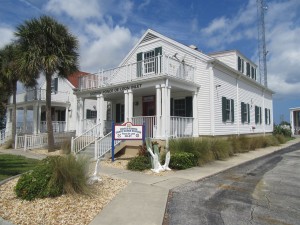
To our welcomed surprise, Lucia invited us to visit her at the U.S. Coast Guard Ponce de Leon Inlet station in NSB. After a few tries to coordinate her work schedule with us needing to bike there in decent weather, we had a break between rains one Sunday afternoon and were able to visit with her. Lucia was a couple of days into her shift of a few days on, and was about to enjoy a couple of days off. Because of that schedule, the station supports their staff with housing quarters, a dining room (that’s my term—perhaps they call it a “mess?”), a fitness facility, and other basic and modest comforts.
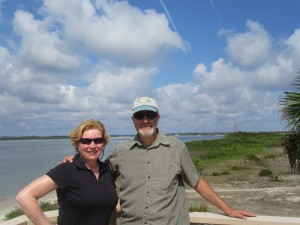
After showing us the administrative offices, we were invited to come aboard one of the USCG’s offshore vessels: a 45-foot RB-M (Response Boat-Medium) boat. This is a high-speed vessel with a range of 250 nautical miles at 30 knots of speed, and a maximum speed of 42.5 knots. They use this for search and rescue as well as law enforcement. Each mission requires that an engineer be part of the crew, so Lucia is a regular and vital crew member.
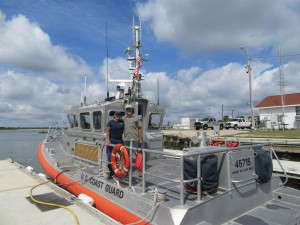
She demonstrated the twin diesel engines that use waterjet propulsion, instead of propellers. Waterjet propulsion protects engines from debris and makes it safer to retrieve someone from the water. The bow of the boat has a survivor’s compartment with seating for five, and the boat also has self-righting stability, meaning that it will right itself within 5 seconds. That’s fast! All of these features make the Coast Guard more effective in performing multiple missions, which means increased survivorship on the seas. We were duly convinced! Should you be interested, you can find more information about the RB-M here: http://www.uscg.mil/acquisition/rbm/pdf/RBM.pdf.
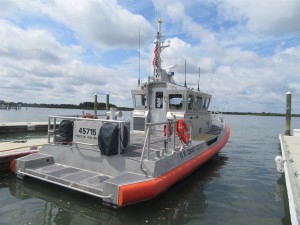
Our tour with Lucia included a peek into their gear shed, where she showed us the heavy survival suits that must be worn when water temperatures are cold, even if the air is warm.
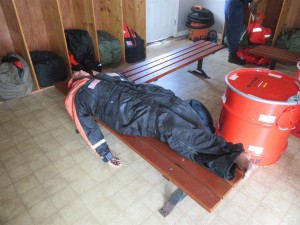
We also walked near the area that houses green and red buoys, a familiar and welcomed sight for cruisers, since we often depend on the Coast Guard to “drop” these buoys as aids to navigation, especially in the shifting sands of the ICW.
As our personal tour came to a close, we thanked Lucia for her time and interest, and for her expertise and service. It was quite the treat to get up close with this part of the US military, which happens to be a constant and vocal presence in our cockpit.
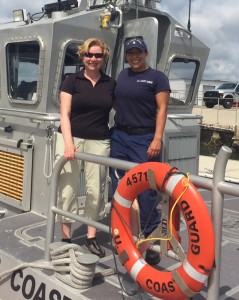
About the U.S. Coast Guard: The USCG has roles in search and rescue (SAR), marine environmental protection (MEP), maintaining river, intracoastal and offshore aids to navigation (ATON), maritime homeland security, and maritime law enforcement (MLE). The U.S. Coast Guard is one of the five armed forces of the United States and the only military organization within the Department of Homeland Security. The USCG has been in existence since 1790.

Thanks for the great piece on our “Coasties”. My Dad served in the Coast Guard out of Norfolk.
Frank, I knew you’d like that post! What a treat to see the USCG up close!
What interesting experiences you are having! Thanks for sharing your “inside” look at the USCG.
Thanks Michele. The tour of the USCG station was certainly a highlight! And one of the benefits of staying in a town long enough to make local friends.
Love your description of your USCG visit! My son has been in the CG just about 4 months. He’s considering MK rate, machinery tech, so he’d be working on Diesel engines. He’s stationed in Alaska on a cutter. i love his choice of CG!